HSS Stratocaster Guitar SSS/HH/Tele Wiring Mod
| 08/06/2025 | Written By: Kim Ippolito | Formatted/Edited By: Lauren Ippolito |
Overview
The HSS configuration is billed as the "most versatile" Stratocaster configuration, yet the standard HSS wiring only only adds one new sound (bridge humbucker) in replacement of another (bridge single-coil). We are definitely not leveraging the flexibility that the HSS configuration can provide! So I designed the electronics for an HSS Strat to be a suitable stand-in for all of the possible sounds from two popular pickup configurations: SSS (5 positions), HH (3 positions). This requires an additional mode selector (which I employed a push-pull pot on the volume knob). And as a bonus, with the remaining available positions, I added a Tele(caster) mode:
- SSS (Single Coil) (e.g., Stratocaster)
- HH (Dual Humbuckers) (e.g., Les Paul, SG, Telecaster HH, or Jaguar HH)
- Tele (Bridge and Neck) (e.g., Telecaster)
The HH (Dual Humbucker) configuration makes the Strat less bright with a fuller sound. So having the flexibility to switch between SSS and HH mode will provide more flexibility, which will allow one axe to be useful for a wider range of music styles.
Modes / Switches
Since the HSS only contains one Humbucker, this mod emulates the HH mode by treating the M and N pickups as the neck Humbucker. The two "modes" are as follows:
| SSS (Single Coil) | HH (Dual Humbuckers) | |
| 1 | B2 | (B1+B2) |
| 2 | B2 || M | (B1+B2) || (M+N) |
| 3 | M | (M+N) |
| 4 | M || N | (B1+B2)+(M || N) - Alternative for position 2 |
| 5 | N | (B1+N) - "Tele" Mode |
The two modes for the 5-way switch. B1,B2 are the two splitable bridge pickups in the humbucker, M is the middle single-coil pickup, and N is the neck pickup. A||B = parallel, and (A+B) = serial.
Note: When planning this design, I had wanted position 4 of the Dual Humbucker mode to be (B2+M), but with the commonly available passive guitar electronics, I was only able make position 4 be (B1+B2)+(M || N). This was a reasonable concession since this is still humbucking and produces a unique sound. It is similar to position 2 with all pickups on, but increases output and puts more emphasis on the bridge humbucker.
In addition to the Mode switch, here are all of the features I included in my design:
- Mode Switch (via push-pull switch on the Volume pot) selects between SSS (Single Coil) when in the "Down" position and HH (Dual Humbuckers) when in the "Up" position.
- PTB (Passive Treble and Bass) Tone Control which adds an additional tone pot - where Pot 1 is the standard Treble Cut circuit and Pot 2 is a Bass Cut circuit.
- Blower Switch (via push-pull switch on the Tone 1 pot) which bypasses the Tone and Volume circuits when in the "Up" position.
- Treble Bleed Circuit on the Volume pot.
- Phase Reversal (via a separate 4PDT mini-switch) which applies to positions 2 and 4 in the SSS (Single-Coil) mode, and applies to ALL positions in the Dual Humbuckers mode - giving you 7 additional "sounds".
The only visual change to the standard 3 knob Stratocaster is the addition of a mini-switch for Phase Reversal, which I placed between the Tone 1 and Tone 2 pots. If you don't want to drill a hole into the pickguard, then you can skip the Phase Reversal switch.
Pickup Selection Stage
The circuit diagram for the Pickup Selection Stage, which includes the Mode Switch and Phase Reversal Switch is shown below:

This circuit requires a four-conductor bridge humbucker and two single-coils that have different polarities (one North and one South) so that they can behave as a neck humbucker. In my case, I have a Squier Contemporary HSS guitar with a Seymour Duncan JB Trembucker in the bridge position, and the two original Squier medium output ceramic single-coils that have different polarities.
This Pickup Selection Stage utilizes the Fender 5 Position Super Switch rather than the more typical 5-position Pickup Selector Switch.
Volume and Tone Stage
The output of the pickup selection stage is fed into the input of the second stage: the Volume and Tone Stage. The circuit diagram for this second stage, which includes the PTB Tone Control, a Blower Switch, and a Treble Bleed Circuit, is shown below:
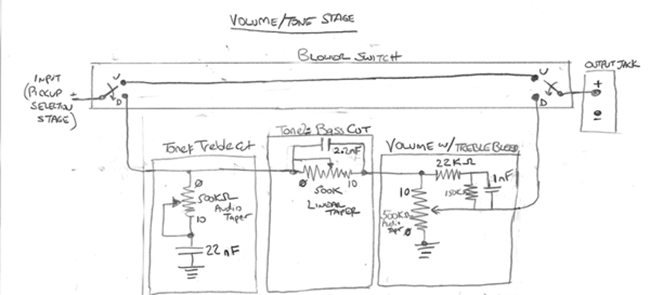
Wiring Diagram
Based upon the circuit diagrams for the two stages, I put together a wiring diagram, trying to keep the wires in a few "lanes" (identified by different color wires in the diagram):
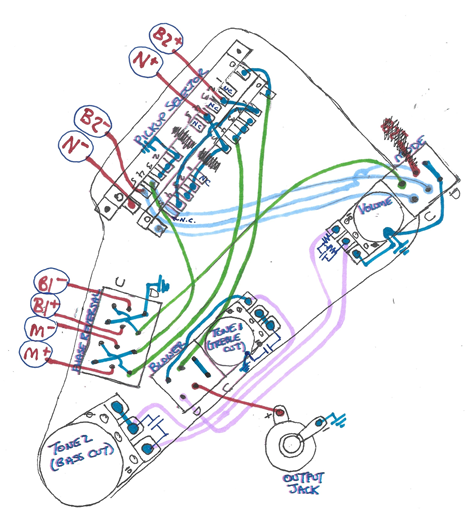
The wiring diagrams for each individual component is shown below (note that the "A"-"D" labels in the pickup selector diagram match the labels used in the Pickup Selection Stage circuit diagram):
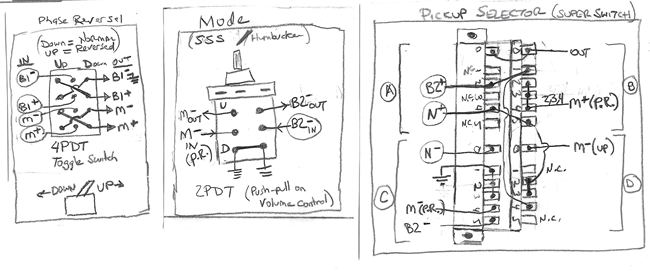
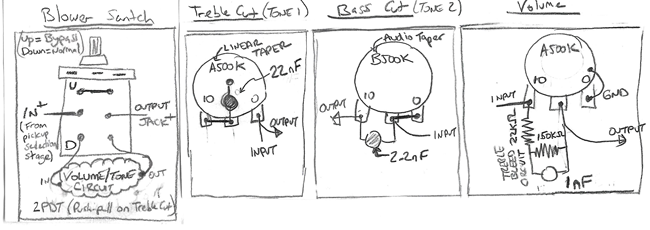
Implementation
Here are a few pictures of the mod (where the left image shows what it looked like after soldering the components together, and the right image shows what it looks like after installing and soldering into the actual pickguard):
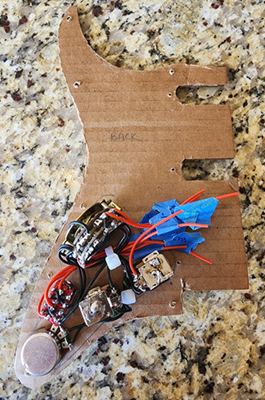
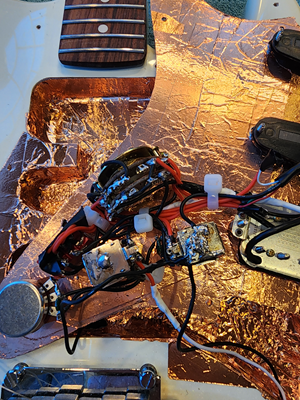
As you can see, I put copper tape over the pickguard and inside the entire cavity, which connects all of the pots and switches to the same ground. Thus, I only needed to run a ground from the top (ground) of volume pot to (a) the output jack, (b) the metal bridge, and (c) the ground wire of the humbucker.
Parts List / Cost
Here is the part list for this mod:
| Parts Lists | ||
| Item | Cost | |
| 1 | Fender Super Switch | $9.14 |
| 1 | Jiuwu B500K Ohm Pots | $7.29 for 5 (but only need one) |
| 2 | Musiclily A500K Ohm Push-Pull Pots | $12.25 for 2 |
| 1 | Twidec Mini Toggle Switch | $9.99 for 2 (but only need one) |
| 1 | 22K Ohm Resistor | $11.59 for 1280 piece resistors kit |
| 1 | 150K Ohm Resistor | |
| 1 | 1 nF Capacitor | $16.99 for Hilitchi Polyester Film Capacitor kit |
| 1 | 2.2 nF Capacitor | |
| 1 | 22 nF Capacitor | |
| 1 | BNTECHGO 22 Gauge Silicone Wire Spool (100 ft) | $12.48 |
| 1 | Soldering iron kit | $19.06 |
| 1 | LOVIMAG Copper Foil Tape (66 ft) | $15.49 |
In my case, I was able to reuse many of the components I already had, thus the cost was much less than listed above.
Final Thoughts
I had tried several different designs before I ended up with this one. I am very happy with how this final version turned out!
A possible additional modification: Note that I used a 500 kOhm potentiometers for the Volume potentiometer. This is the typical value for humbucker pickups while 250 kOhm is typical for single-coil pickups. The reason for the reduction to 250 kOhm is to darken the brighter single-coil pickups (and to not darken the already darker humbucker). However, in my design, it uses the 500 kOhm for all positions of the pickup selector. In my opinion, this isn't a bad compromise, but others may disagree. So if you want to make positions 3 and 5 "see" 250 kOhm instead of 500 kOhms, you could put a 500 kOhm resistor on the 3 and 5 positions of the super-switch in section A (as labelled in the Pickup Selection Stage diagram) - with the other end connected to ground. The drawback is that this will apply to both modes - SSS and HH modes. Thus, in HH mode, position 3 (M+N) and position 5 (B1+N) will also be "darkened" with the lower resistance. However, these two positions have two pickups in series which will also darken the sound. Thus, the sound may become too muddy. For this reason, I did not include this in my design. But feel free to experiment for your situation.
